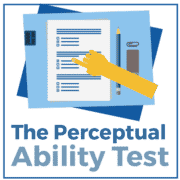
The Perceptual Ability Test, also known as the PAT, is one of the four tests of the Dental Admission Test. It is essential to do well on this test as it is scored separate of the other three tests – Survey of the Natural Sciences, Reading Comprehension, and Quantitative Reasoning – that formulate your Academic Average score. Therefore, you want to rock the PAT since its score stands alone from the others.
I also believe the PAT is one of the easiest sections of the DAT to do well on. The Academic Average and the PAT scores are the two scores that will be looked at first. A high PAT score will add strength and a buffer to your application which will help out with any area that may be less than ideal.
General Guidelines for the PAT
Here are some general guidelines that you should follow to help you obtain a higher overall score:
Elimination: Look at the possible answers for each question and find which ones you can eliminate. Eliminating answers will help you get rid of the distractors and come up with the right answer more quickly. This is a helpful thing to do with every question on the DAT; there are distractors on every question.
Time Management: Make sure you are completing the subtests in a timely manner. You have 40 seconds max per question so you can’t afford to waste time on this test. The best way to become efficient in your time management on the PAT is to follow the following guidelines.
Practice: Do practice problems!
Practice: Do more practice problems!
- Practice: Do even more practice problems! Do as many practice tests as you can for the PAT; the more the better! This is the only way to crush the PAT.
Overview
The PAT has 90 questions in total and is made up of 6 subtests with 15 questions on each one. Here is an explanation of each subtest:
- Apertures (Keyholes): A 3D object is shown along with the outline of 5 apertures of openings and you must determine which aperture the 3D object could pass through. There is only one correct aperture for each 3D object. Prior to passing through the aperture, the object may be turned in any direction and/or started through the aperture on a side not shown. Once it has started through the aperture, it may not be twisted or turned. It must pass completely through the opening which is the exact shape of the appropriate external outline of the object. Both objects and apertures are drawn to scale, therefore, it is possible for an opening to be the correct shape, but too small for the object. Differences in size are large enough to determine by eye. There are no irregularities in any hidden portion of the object. However, if the figure has symmetric indentations, the hidden portion is symmetric with the part shown.
View Recognition (Top/Front/End): You are presented with pictures from the top, front, and end views of various solid objects. The views are without perspective; meaning that the points in the viewed surface are viewed along parallel lines of vision. The problems will show you two views of the object with four alternatives of the object in order to complete the missing view. Hidden lines are shown as dashed lines.
Angle Discrimination (Angle Ranking): Four angles are presented and you must rank them from smallest to largest.
Paper Folding (Hole Punches): A flat square of paper is folded one or more times and then a hole is punched in it. The solid lines indicate the position of the folded paper. The folded paper always remains within the edges of the original square. The paper is never turned or twisted. You have to mentally unfold the paper and determine the position of the holes in the original square.
Cube Counting: A figure made by cementing together cubes of the same size is presented for each set of problems. After the cubes have been cemented together they were painted on all sides EXCEPT for the bottom on which they are resting. The only hidden cubes are those required to support other cubes. You have to examine each figure closely to determine how many cubes have how many of their sides painted.
3D Form Development (Pattern Folding): A flat pattern will be presented which will be folded into a 3D figure. The correct figure is one of the four given to the right of the pattern. There is only one correct figure in each set. The outside of the pattern is what is seen at the left.
Tips & Tricks
Here are some different test taking methods that many people have found helpful for the PAT. I would recommend trying them all out and seeing which ones work best for you. I only used several of these and found that others weren’t helpful to me. You just need to put them in practice and see what helps you the most. The answers for the problems are listed at the bottom of this section.
Apertures (Keyholes)
- Top/Front/End Method: This subtest is in my opinion the most difficult. There is no method that I’ve seen to make this easy. The best way to approach it is the same as the View Recognition (Top/Front/End) subtest. Visualize each object from the top, front and end views. Remember the answers can be in any of those views or even diagonal views. You really need to practice these problems a lot in order to get good at visualizing the objects from all the different views. I found this video to be helpful at explaining how to visualize the objects for this subtest.

View Recognition (Top/Front/End)
- Line Counting Method: This is a method that has been used for awhile, but the DAT now has problems on this subtest that cannot be answered with this method. Therefore, don’t rely solely on this method, because it won’t help you with most of the problems. Look at each view (top, front, or end) that is provided in the question and count how many lines there are for that view. Then visualize each answer choice from those respective views and count how many lines there are. Eliminate the answer choices that do not have matching numbers of lines for each view and you’ll arrive at your answer.
- Top/Front/End Method: Visualize each answer choice as a 3D object based off of the top, front, or end views that are provided in the problem. Compare the 3D object that you have visualized to the answer choices and eliminate the distractors and select the correct answer.
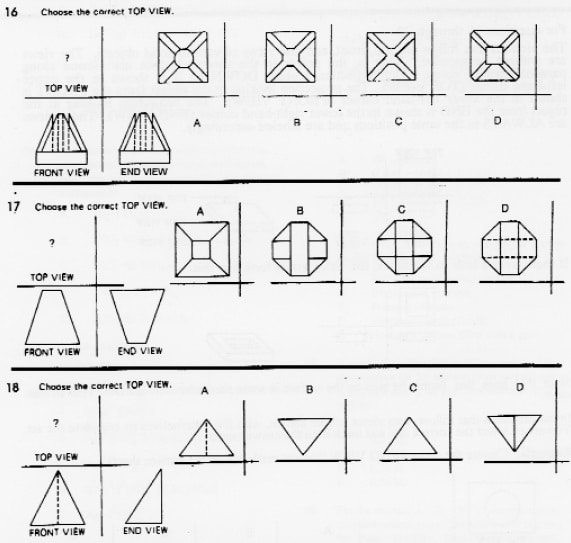
Angle Discrimination (Angle Ranking)
- Laptop Method: Imagine each angle is a laptop viewed from the side. Imagine one line of the angle is the base of the laptop and will not move and the other line of the angle is the screen and will move. Then imagine which laptop would be easiest to close. The laptop that closes the easiest would be the smallest angle. I found this method helpful to me in completing this subtest.
- Laser Method: This method can be used to distinguish a smaller angle between two angles. The two angles must have a similar vertical/horizontal line that you can compare to. Imagine the vertical/horizontal line as the base of the laser and is laying flat on the ground. The other line is the gun base that will shoot the laser. The laser with the steepest slope will be the smaller angle. Figure 1 has the smallest angle in this example.
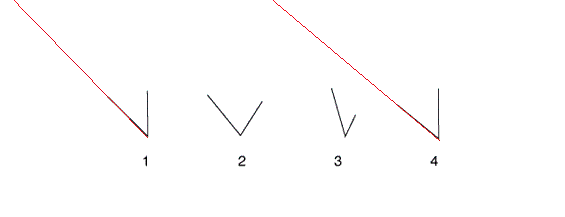
- Circle Method: This method can be used to distinguish a smaller angle between two angles. I prefer this method along with the Laptop Method for this subtest. Concentrate on the interior areas of the two similar angles and mentally draw a circle around the innermost areas of the angles. Look back and forth between the two angles quickly and you should be able to distinguish between the two which one has the smallest angle. Figure 1 has the smallest angle in this example.

- From A Distance: I have heard a lot of people say to sit back in your chair and view the angles from a distance for this subtest. Perhaps that helps for the Laser Method or for some people, but I found the opposite. I found it difficult to distinguish between angles when you’re sitting far back and not up close looking at them. I was up close and personal with the computer during this subtest and found that to be the most helpful for me with the Circle Method and even the Laptop Method. I preferred it that way, but to each their own.
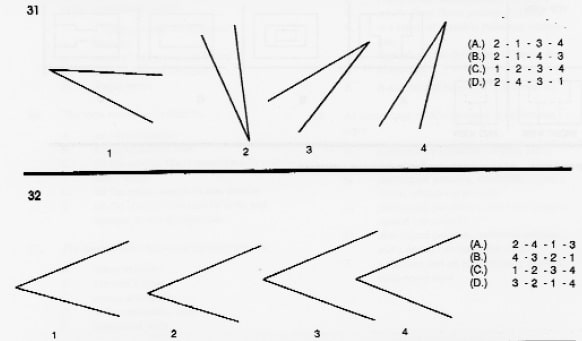
Paper Folding (Hole Punches)
- Tic-Tac-Toe Method: I didn’t use a method for this section. I just visualized the hole and mentally unfolded the paper to determine where the other holes will be. There may be only ½ of a hole punch instead of a complete hole punch in the paper which makes it a little more challenging to figure out. I found this subtest to be the easiest. The method taught, however, is that you draw a 4×4 square and mark an X where the hole is punched in the paper in relation to the 4×4 square. Then mark an X for each square that will have a hole as you unfold the paper.
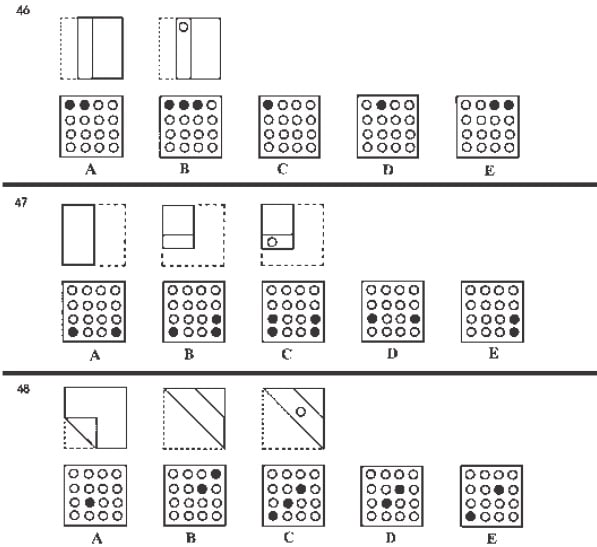
Cube Counting
- Cube Counting Method: This is probably the second easiest subtest to do well on. For each figure presented in this subtest make a table like the following:

The numbers represent the number of sides painted on the cubes in the figure. Here is an example of counting up the number of painted sides on each cube in a figure:

Here is your updated table now with the tally count of the number of sides painted for each cube in the figure:
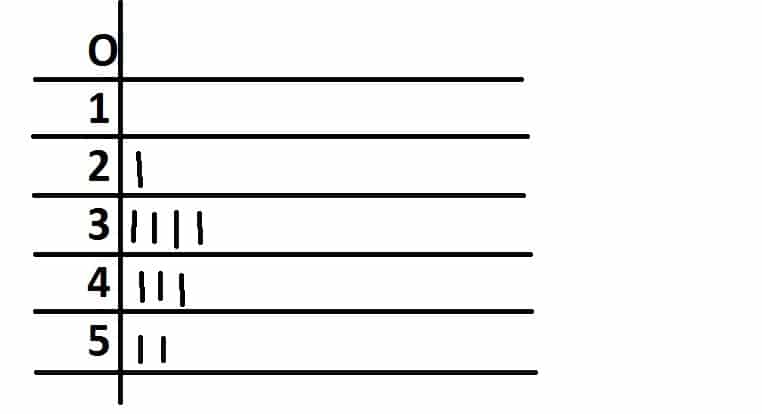
Now you just have to answer the questions according to your table. Pay attention to any hidden cubes, make sure you count right and you’ll ace this subtest.

3D Form Development (Pattern Folding)
- Side Counting Method: For some problems you may be able to use this method, but it will not work for all problems. Find the largest shape within the pattern and count the number of sides of the shape. Compare it with the answer choices to determine the correct choice, or at least to eliminate some of the choices.
- Shape Matching Method: Find the largest shape within the pattern and compare this shape with the shapes in the answer choices to determine the correct answer, or at least to eliminate some of the choices.
- Color Matching Method: This method is similar to the Shape Matching Method except that you compare a shaded part of the flat pattern to the corresponding part on the folded pattern in the answer choices. Make sure that the shaded part is in the correct place on the folded pattern. Continue to make sure that all the shaded parts correspond to the answer choice in order to determine the correct one.
Answers

Apertures (Keyholes)
1. C
2. A
3. B
4. A
View Recognition (Top/Front/End)
16. B
17. D
18. C
Angle Discrimination (Angle Ranking)
31. D
32. C
Paper Folding (Hole Punches)
46. A
47. C
48. C
Cube Counting
61. B
62. C
63. C
64. D
3D Form Development (Pattern Folding)
76. B
77. C
78. A
79. D
80. C
Time
You have 60 minutes to complete the PAT. There are 6 subtests on the PAT, but they all vary in difficulty. Some are easier than others and will vary in how much time they take to complete.
You should try to complete each subtest in less than 10 minutes. However, the Angle Discrimination (Angle Ranking), Paper Folding (Hole Punches), and Cube Counting subtests are much easier than the others and should be completed in well under 10 minutes. This will allow you extra time if needed for the other subtests which are more time consuming.
Review Materials
There are quite a few different review materials for the PAT and they are all fairly similar and good resources. You really can’t go wrong with any of them out on the market today. Some of the many resources available include: Kaplan, The Princeton Review, or Crack DAT PAT.
Overall, I’d say the course that does the best job at preparing you for the PAT is Crack DAT PAT. They are the most similar to the actual PAT as far as difficulty and give you all the tools necessary to get a competitive score. It also has some great benefits such as: unlimited use, instant download, and no expiration date.
Kaplan and The Princeton Review are both great comprehensive review courses that do a great job as well at preparing you for the PAT and would also provide you with the additional review material for the remaining sections of the DAT. They could be great resources as well to consider. You can also see a full comparison of the best DAT courses here.
The PAT can be your best friend or your worst enemy. Some find it challenging to mentally visualize the figures well to others it comes more easily. Either way, you have to put in the time to practice these types of problems. This test is unique and the only way to excel on it is to practice, practice, and practice!
If you have any questions, comments, or advice that you think might be useful to others then feel free to share it below!
Bryce Welker is an active speaker, blogger, and regular contributor to Forbes, Inc.com, and Business.com where he shares his knowledge to help others boost their careers. Bryce is the founder of more than 20 test prep websites that help students and professionals pass their certification exams.




